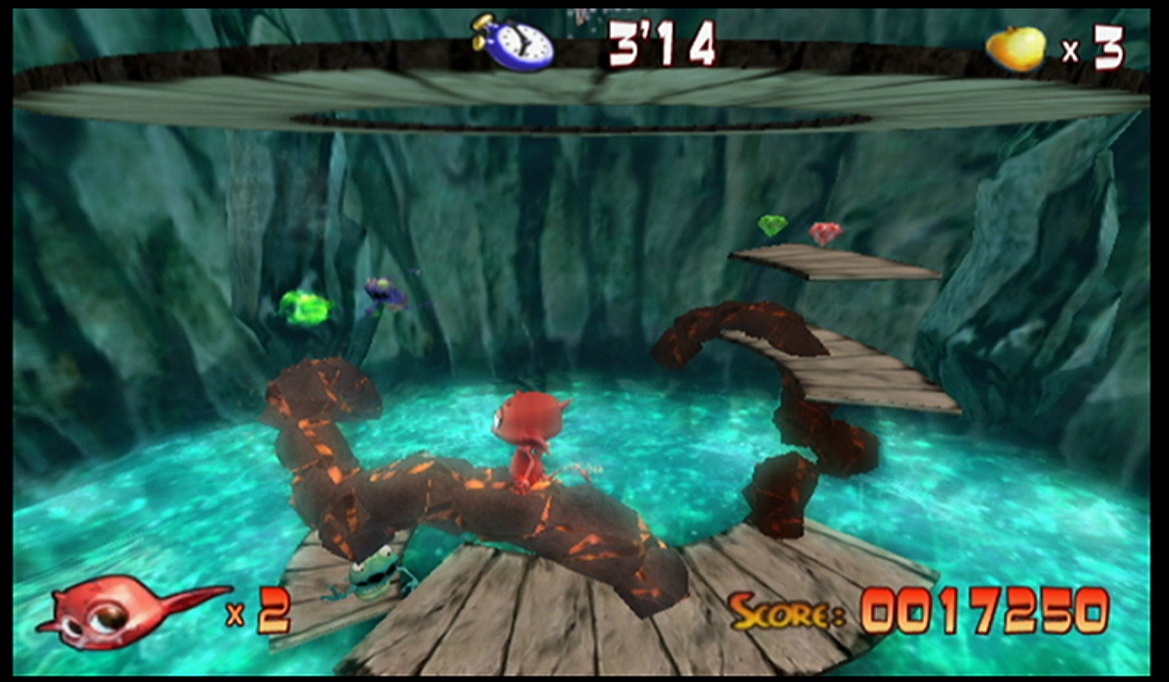Cocoto Platform Jumper made its first appearance in 2004, but its roots delve even further back into the past. As you smite mundane enemies and awkwardly jump your way through the five increasingly difficult levels, you are reaching back through the history of platforming to a time when games were punishingly hard and heroes had uncomfortably limited skill sets. Unfortunately, Platform Jumper is a pale shadow of its predecessors. Cocoto poorly handles such concepts as speed and momentum, and the herky-jerky running and jumping make it quite difficult to match the precision that the game often demands. The resulting gameplay is frustrating and shallow. Yes, the game can be beaten, and yes, it is tough. But there are so many better, similar games out there that even those hungry for a nostalgic challenge are advised to seek sustenance elsewhere.
The five areas in the game each have four levels and a boss. Each level has a couple of checkpoints and will likely take you at least a few tries to complete, so at least it feels as if there's a reasonable amount of content. Every level is structured around a tall, invisible column. As Cocoto, a weird little demon creature, you ascend to the top of each level by jumping up the platforms that encircle this column. As you progress, you'll encounter the standard set of platforming elements: moving platforms, slippery surfaces, enemies that move in patterns, enemies that shoot at you, collectible jewels, extra lives, and a few power-ups. You'll also collect apples that will scatter when you are hit; get hit without any apples and you're dead. There are a lot of familiar elements in Platform Jumper, but a distinct lack of unique ones.
Cocoto also has the genre-standard jump and double jump, but he's not very good at them. He shoots up into the air and plummets down with an alarming speed that is oddly disconnected from his deliberate running momentum. It's tough to get a feel for airborne maneuvers, and even tougher to execute precision jumps. This makes Platform Jumper quite challenging in later levels, but it's the kind of detached, masochist challenge in which your main struggle is with the stilted controls, not the actual level design. Victory doesn't bring a sense of accomplishment, only a sigh of relief.
The one remotely fun element here is Cocoto's ability to create an arcing rock bridge in the direction he's facing. Players familiar with Rainbow Island will recognize the mechanic here, though Cocoto does it with significantly less panache. He can't jump onto these bridges, but he can walk on them to get a better position or cross a gap. He can also stack them two high, and they are good for destroying enemies or blocking projectiles. However, these arcs do have serious limitations; they crumble fairly quickly and are easily destroyed by enemy projectiles. They are fun to use and add some welcome variety, even though they look a bit strange as they sprout in front of the tiny demon's feet. It's a neat trick that, though certainly useful, feels like a missed opportunity. The rock arc could have been implemented in some interesting platforming puzzles.

Unfortunately, Cocoto never gets anywhere near interesting. Though the levels look different and feature different enemies, they all feel pretty much the same. The bosses at the end of each level require a bit of figuring out, but once you discover their individual weaknesses, victory is just a matter of repetition and exploitation. The multiplayer modes are a misery-loves-company affair that let you introduce a few friends to the awkward, stilted controls that are the bane of Cocoto's existence. With smoothly functioning mechanics and some thoughtful design, Platform Jumper could have captured some of the fun of its old-school platforming precursors. But it doesn't have those things, which leaves it a sad also-ran that'll make you look for better ways to spend your money.